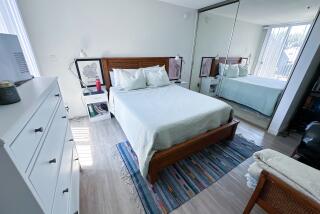Vinyl Justice
- Share via
If the words “vinyl flooring” stir up thoughts of grandma’s house, think again. Except for the easy and quick-care aspects of her linoleum, modern sheet-vinyl floor coverings have nothing in common with linoleum--not even a name.
Those floors of yore were, in effect, enamel-decorated felt or mixtures of ground cork, fillers and linseed oil that came in a few simple patterns. And, as practical and popular as linoleum was, it suffered from an image problem.
“Those products, as we knew them, were products that came about because people couldn’t afford anything else. There was a [negative] attitude about linoleum,” says Leonard Ludovico, vice president of product styling and design at Congoleum Corp. in Mercerville, N.J.
But, oh, what a difference 40 years make. Sheet-vinyl floors, as they are known today, are high-tech, engineered products that come in hundreds of patterns, colors and finishes and blend performance with style and beauty. Although still less costly than some materials, such as marble and stone, sheet vinyl can match or surpass wood and ceramic tile in price.
And vinyl has gotten some respect. “Beautiful. Absolutely no question about it,” says Roslyn S. Blumberg of RSB Interiors Inc. in Mineola, N.Y.
Sheet-vinyl flooring is part of a wider category of flooring materials known as resilient flooring, which includes vinyl tile and the newer vinyl “planks”--strips that resemble wood flooring and are installed like vinyl tiles.
Vinyl has long been a favorite in the kitchen, and that trend continues; 72% of kitchen flooring in the United States is vinyl, according to the Resilient Floor Covering Institute. But sophisticated styles--such as faux marble, wood and stone--and new customized installations achieved by mixing solids and patterns have greatly expanded sheet-vinyl flooring’s decorating capabilities, so it is showing up in other rooms as well.
“Vinyl has gotten high-style,” says interior designer Nancy Salemi, head of Nancy Salemi Design Studio in Hauppauge, N.Y.
Blumberg, whose preference leans toward parquet “if you can afford it,” nevertheless sees advantages in vinyl. “It’s soft,” she says, and “tiles are harder on your feet.”
Vinyl flooring is finding its way into dens, family rooms, great rooms and home offices. In today’s airy homes, these high-traffic rooms often open onto each other, creating the need to deal with them both individually and as a whole, says Tom Cook, corporate creative director at Armstrong World Industry’s floor division.
The engineered durability of today’s floors solves the traffic problem, and coordinated solid and patterned designs provide the unifying look to bring the spaces together while keeping them open and separate. The unity, Cook says, comes from the fact that sheet vinyl, as opposed to tiles and wood flooring, offers a virtually seamless effect that prevents the eye from dealing with too many lines. Even where sheet vinyl is seamed, those seams, when sealed by professional installers, are barely noticeable. (The sealed seams also make the floor impervious to water, an advantage over using individual vinyl tiles.)
Style aside, vinyl flooring is popular with homeowners now mainly for the same reason grandma and her generation liked their linoleum: It’s low maintenance. Advanced nonstick finishes keep dirt and dust from adhering to floor surfaces so that a sweeping or damp mopping is all that’s needed to keep them clean. Many floors come with long-term warranties against permanent staining.
In addition, since most sheet vinyl is made with a foam base, it is more comfortable to stand on for long periods than hard-surface floors, and it gives dropped glasses and dishes a better chance of surviving.
Although today’s floors have been evolving since the 1950s, it was only about 10 years ago that the technology to produce the current high-tech products was developed, says Congoleum’sLudovico. And it was only as recently as five years ago that the crisp and long-lasting patterns and colors became possible through digital imaging.
The result is a wide variety of patterns and grades that range in price from about $15 to $45 a square yard--without installation. Installation prices depend on a number of variables. The best advice is to get an estimate for a complete job, which includes the price of everything that goes into a complete installation.
On the lower end of the price scale is rotovinyl flooring. This is produced by placing an image on a foam base and coating it with a clear vinyl or urethane layer to protect the design from wear and tear. More expensive but a lot more durable is inlaid vinyl. This is the product of a process that fuses millions of vinyl granules under heat and pressure to form a solid material in which the colors and patterns run completely through to the backing.
Whereas vinyl tile can be installed by an adept do-it-yourselfer, sheet vinyl is best left to a professional installer.
* Tiles courtesy of Linoleum City Inc.


